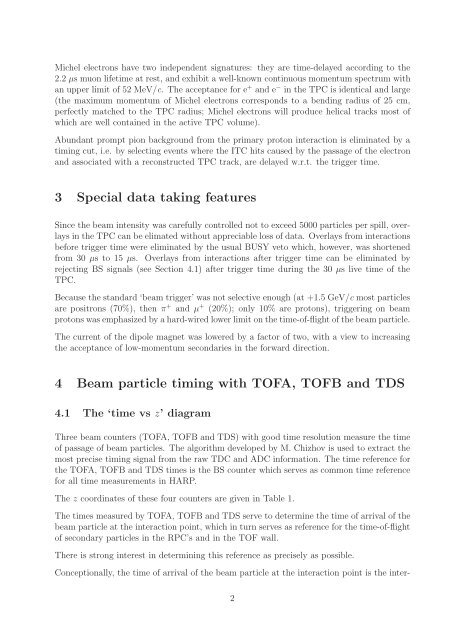Water data analysis: data reduction from beam and ITC info
Water data analysis: data reduction from beam and ITC info
Water data analysis: data reduction from beam and ITC info
Create successful ePaper yourself
Turn your PDF publications into a flip-book with our unique Google optimized e-Paper software.
Michel electrons have two independent signatures: they are time-delayed according to the<br />
2.2 µs muon lifetime at rest, <strong>and</strong> exhibit a well-known continuous momentum spectrum with<br />
an upper limit of 52 MeV/c. The acceptance for e + <strong>and</strong> e − in the TPC is identical <strong>and</strong> large<br />
(the maximum momentum of Michel electrons corresponds to a bending radius of 25 cm,<br />
perfectly matched to the TPC radius; Michel electrons will produce helical tracks most of<br />
which are well contained in the active TPC volume).<br />
Abundant prompt pion background <strong>from</strong> the primary proton interaction is eliminated by a<br />
timing cut, i.e. by selecting events where the <strong>ITC</strong> hits caused by the passage of the electron<br />
<strong>and</strong> associated with a reconstructed TPC track, are delayed w.r.t. the trigger time.<br />
3 Special <strong>data</strong> taking features<br />
Since the <strong>beam</strong> intensity was carefully controlled not to exceed 5000 particles per spill, overlays<br />
in the TPC can be elimated without appreciable loss of <strong>data</strong>. Overlays <strong>from</strong> interactions<br />
before trigger time were eliminated by the usual BUSY veto which, however, was shortened<br />
<strong>from</strong> 30 µs to 15 µs. Overlays <strong>from</strong> interactions after trigger time can be eliminated by<br />
rejecting BS signals (see Section 4.1) after trigger time during the 30 µs live time of the<br />
TPC.<br />
Because the st<strong>and</strong>ard ‘<strong>beam</strong> trigger’ was not selective enough (at +1.5 GeV/c most particles<br />
are positrons (70%), then π + <strong>and</strong> µ + (20%); only 10% are protons), triggering on <strong>beam</strong><br />
protons was emphasized by a hard-wired lower limit on the time-of-flight of the <strong>beam</strong> particle.<br />
The current of the dipole magnet was lowered by a factor of two, with a view to increasing<br />
the acceptance of low-momentum secondaries in the forward direction.<br />
4 Beam particle timing with TOFA, TOFB <strong>and</strong> TDS<br />
4.1 The ‘time vs z’ diagram<br />
Three <strong>beam</strong> counters (TOFA, TOFB <strong>and</strong> TDS) with good time resolution measure the time<br />
of passage of <strong>beam</strong> particles. The algorithm developed by M. Chizhov is used to extract the<br />
most precise timing signal <strong>from</strong> the raw TDC <strong>and</strong> ADC <strong>info</strong>rmation. The time reference for<br />
the TOFA, TOFB <strong>and</strong> TDS times is the BS counter which serves as common time reference<br />
for all time measurements in HARP.<br />
The z coordinates of these four counters are given in Table 1.<br />
The times measured by TOFA, TOFB <strong>and</strong> TDS serve to determine the time of arrival of the<br />
<strong>beam</strong> particle at the interaction point, which in turn serves as reference for the time-of-flight<br />
of secondary particles in the RPC’s <strong>and</strong> in the TOF wall.<br />
There is strong interest in determining this reference as precisely as possible.<br />
Conceptionally, the time of arrival of the <strong>beam</strong> particle at the interaction point is the inter-<br />
2















